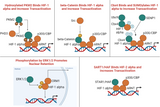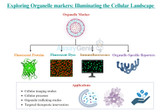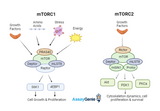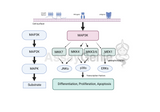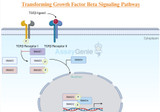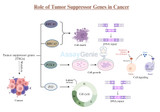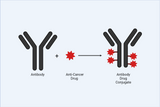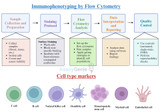Blog
Unlocking Cellular Adaptation: The HIF Enhancer Pathway and Its Implications in Hypoxia Response
Hypoxia, or low oxygen levels, poses a significant challenge to cells, necessitating rapid and efficient adaptation mechanisms. The Hypoxia-Inducible Factor (HIF) pathway is a well-known regulator of cellular responses to hypoxia, orchestrating the expression of genes involved in angiogenesis, erythropoiesis, and glycolysis. It plays a pivotal role in cellular adaptation to low oxygen conditions, ensuring survival and homeostasis in diverse physiological and pathological settings. Recent studies have uncovered an additional layer of complexity in HIF regulation, known as the HIF enhancer pathway. This article explores the mechanisms, regulation, and significance of the HIF enhancer pa
…
12th Jan 2024
Exploring Organelle Markers: Illuminating the Cellular Landscape
The eukaryotic cell is a complex and dynamic system with distinct membrane-bound compartments known as organelles, each performing specialized functions essential for cellular survival. To better understand the intricate workings of these organelles, scientists employ organelle markers – molecular tools that provide a means to visualize and study these structures. In this article, we delve into the fascinating realm of organelle markers, discussing their significance, types, and applications in unraveling the mysteries of cellular biology. Organelle Markers: Painting a Molecular Canvas Organelle markers play a pivotal role in cell biology research by allowing scientists to
…
11th Jan 2024
Understanding the mTOR Signaling Pathway: A Key Player in Cell Growth and Metabolism
The mammalian target of rapamycin (mTOR) signaling pathway is a crucial regulator of cell growth and metabolism, responding to environmental cues and cellular energy status. This pathway's significance lies in its role in various physiological processes and its implications in numerous pathologies, including cancer, neurological diseases, and metabolic disorders.
window.SHOGUN_IMAGE_V2_ELEMENTS = window.SHOGUN_IMAGE_V2_ELEMENTS || new Array();
window.SHOGUN_IMAGE_V2_ELEMENTS.push({ uuid: 's-84730463-591d-4e27-a9ad-0dd265e606e9' })
Figure: An overview of mTORC signaling pathways. Overview of mTOR Signaling: mTOR, a serine/threonine kinase, functions as a part
…
5th Jan 2024
MAPK Signaling: Unraveling the Pathway of Mitogen Stimulation
Introduction to MAPK Signaling in Cellular Processes Mitogen-Activated Protein Kinase (MAPK) signaling pathways are crucial in transmitting signals from the cell surface to the DNA in the cell nucleus. These pathways play a pivotal role in various cellular processes, including proliferation, differentiation, and response to environmental stress. Understanding the intricacies of the MAPK signaling pathway, especially in response to mitogen stimulation, is fundamental for advancing our knowledge in cell biology and therapeutic strategies. The Mechanism of MAPK Signaling Pathway
window.SHOGUN_IMAGE_V2_ELEMENTS = window.SHOGUN_IMAGE_V2_ELEMENTS || new Array();
wi
…
5th Jan 2024
Deciphering the Intricacies of TGF-Beta Signaling Pathway
Transforming Growth Factor-Beta (TGF-β) signaling pathway plays a pivotal role in orchestrating various cellular processes, ranging from embryonic development to tissue homeostasis and immune response modulation. This intricate pathway is crucial for maintaining cellular balance, and dysregulation can contribute to a myriad of diseases, including cancer, fibrosis, and immune disorders. In this article, we delve into the key components and mechanisms that characterize the TGF-β signaling pathway. Key Components of TGF-Beta Signaling Pathway: TGF-β Ligands: The TGF-β family comprises multifunctional cytokines, with TGF-β1, TGF-β2, and TGF-β3 being
…
24th Aug 2023
The Role of Tumor Suppressor Genes in Cancer: Knudson Hypothesis & Oncogenes
The focus of this article is Tumor Suppressor Genes. There are various different types of tumor suppressor genes, with BRCA being one of the most popular. The role of Tumor Suppressor Genes in Cancer, Oncogenes and Knudson Hypothesis are also discussed. Key Takeaways Tumor suppressor genes help prevent tumor formation by controlling cell growth. Mutations in these genes can lead to cancer by disrupting their normal functions. Examples include p53, BRCA1, BRCA2, and PTEN. The Knudson Two-Hit Hypothesis explains how mutations in these genes can lead to cancer. Understanding tumor suppressor genes aids in developing cancer treatments. What are Tumor Suppressor Gene
…
24th Aug 2023
Antibody Conjugation: Techniques and Applications
Antibody conjugation is a pivotal technique in biomedical research and diagnostic applications. This process involves the covalent attachment of a molecule, such as a drug, toxin, enzyme, or fluorescent dye, to an antibody. The specificity of antibodies to their antigens makes antibody conjugation a powerful tool for targeted delivery in therapeutic contexts and for specific detection in diagnostic assays.
window.SHOGUN_IMAGE_V2_ELEMENTS = window.SHOGUN_IMAGE_V2_ELEMENTS || new Array();
window.SHOGUN_IMAGE_V2_ELEMENTS.push({ uuid: 's-244b29f5-4261-4ef7-974d-e802c13cdca5' })
Overview of Antibody Conjugation Techniques Di
…
24th Aug 2023
Positive Control vs Negative Control
T cell activation is a crucial process in the immune response, playing a pivotal role in how the body responds to pathogens and maintains immune homeostasis. This intricate process involves several key stages and molecules, each contributing to the effective functioning of T cells in the immune system. Understanding the Basics of T Cell Activation Direct conjugation involves the direct covalent attachment of the molecule to the antibody. This method is straightforward but requires careful control of reaction conditions to ensure specificity and retain antibody functionality. Indirect Conjugation Indirect conjugation uses a two-step process. Initially, a reactive group is
…
24th Aug 2023
A Comprehensive Overview of Cell Death
Cell death is an essential aspect of cellular biology that plays a crucial role in development, homeostasis, and disease. In this blog, we try to focus on mechanisms and various types of cell death, shedding light on the scientific underpinnings of apoptosis, necrosis, and regulated necrosis variants.
Table of Contents
Jump to a section:
- Apoptosis
- How to Measure Apopto
…
23rd Aug 2023
Immunophenotyping by Flow Cytometry and Cell Type Markers
Immunophenotyping by Flow Cytometry Immunophenotyping is a technique used in the field of immunology and cell biology to identify and classify cells based on the specific proteins or molecules found on their surfaces, known as cell surface markers or antigens. These markers provide valuable information about the type, state, and characteristics of individual cells within a larger population. Immunophenotyping is particularly important in fields such as immunology, hematology, oncology, and infectious diseases, where understanding cell populations and their properties is crucial. The primary tool used for immunophenotyping is flow cytometry, although other methods like immu
…
23rd Aug 2023
Oxidative Stress: Causes, Biomarkers & Disease
Oxidative Stress Definition
Oxidative stress is a condition that results when the body produces or consumes more reactive oxygen species (ROS) than it can neutralize. ROS are unstable molecules that can damage cells, proteins, and DNA. Oxidative stress has been implicated in a wide range of diseases, including heart disease, cancer, Alzheimer's disease, and Parkinson's disease. In this article, we will discuss oxidative stress and explore its role in disease. We will also look at some of the most common oxidative stress markers.
Oxidants and reductants can be formed in cells by losing or gaining a single electron, which
…
23rd Aug 2023
Autophagy in Focus: Molecular Mechanisms and Functional Insights
Autophagy, a fundamental cellular process, plays an indispensable role in maintaining cellular homeostasis and ensuring the efficient recycling of cellular components. Through this process, cells can adapt to various stressors, ensuring their survival and contributing to overall organismal health. In this blog, we focus on the multifaceted world of autophagy, unraveling its molecular intricacies and understanding its critical significance in cellular physiology and disease prevention.
Table of Contents
…
15th Aug 2023
Cellular Respiration
Discover the intricacies of cellular respiration, a critical process for energy production in cells, encompassing aerobic and anaerobic pathways and their molecular mechanisms Key Takeaways Cellular respiration is a vital biological process for energy production in cells. It involves converting nutrients into ATP, the primary energy currency. Two types: Aerobic (uses oxygen) and Anaerobic (without oxygen). Key components: Mitochondria in eukaryotes, cytoplasm in prokaryotes. Stages of Aerobic Respiration: Glycolysis, Citric Acid Cycle, Oxidative Phosphorylation. Welcome to our in-depth exploration of cellular respiration—an essential process responsible fo
…
24th Jul 2023
A Quick Guide to Myelin
The myelin sheath is an insulating layer around nerve cells. It is made up of a substance called myelin, which is produced by special cells called oligodendrocytes. Myelin protects the nerve cells and to keep them maintain their function. Myelin is important for the proper function of the nervous system. It helps to speed up nerve impulses and prevents them from becoming mixed up. Without myelin, nerve impulses would move slowly and would be easily confused. Myelin is also important for the repair of damaged nerves. When a nerve is damaged, the myelin sheath around it is also damaged. The oligodendrocytes that produce myelin can also repair the myelin sheath. This process is called myeli
…
19th Jul 2023
Converting RPM to G-force in Centrifugation
Centrifuges play a pivotal role in scientific research and various industries, enabling efficient separation and isolation of components within a sample. Understanding the relationship between rotations per minute (RPM) and gravitational force (G-force) is crucial for optimizing centrifuge settings and achieving desired results. In this blog, we will focus on the principles behind RPM and G-force in centrifugation, provide practical insights for accurate conversions, and offer valuable tips and best practices.
…
19th Jul 2023
What is RNAi? All You Need to Know
RNA interference (RNAi), also referred to as Post-Transcriptional Gene Silencing (PTGS), is the process by which RNA molecules silence genes in response to double-stranded RNA. RNA interference (RNAi) causes the downregulation or silencing of specific genes at the post-transcriptional level. It can lead to several effects depending on the targeted gene and its biological function.This article discusses RNAi, the various types of RNAi, its mechanism of action and RNAi therapeutics.
{
"@context": "https://schema.org",
"@type": "BlogPosting",
"mainEntityOfPage": {
"@type": "WebPage",
"@id": "https://www.assaygenie.com/blog/what-is-rna-interference-all-you-need-to-kno
…
13th Jul 2023
Cyclins and Cyclin Dependent Kinase – Review
Cyclins and CDKs are central to cell cycle control, with specific cyclin-CDK pairs regulating different phases, ensuring orderly progression and genomic integrity in cell division. Key Takeaways: Cyclins and CDKs are vital for cell cycle regulation. Cyclins A, B, D, E each pair with specific CDKs to control cell cycle phases. Cdk1, the prototypical CDK, partners with cyclin B for mitotic entry. Cyclin B upregulation and Cdk1 substrates play key roles in mitosis. Proteomic analysis reveals extensive Cdk1 substrates in mitosis. Positive feedback loops amplify Cdk1/cyclin B activity. Cdk1-Plk1 phosphorylation cascade is crucial for spindle assembly and mitosis. Cyclin degradatio
…
10th Jul 2023
Immunometabolism – A therapeutic perspective
What is Immunometabolism?
Immunometabolism is an exponentially growing, multi-disciplinary field of research aiming at deciphering the dynamic cellular and molecular mechanisms that interweave metabolic and immunological processes together. Although the term “immunometabolism” first appeared in the literature in 2011, the first studies investigating the connection between immune and metabolic disorders date back to the late 19th century. Our expanding understanding of how different immune cell functions correlate with particular metabolic configurations during home
…
10th Jul 2023
Pyruvate dehydrogenase (PDH)
Pyruvate dehydrogenase is a complex enzyme involved in the conversion of pyruvate, a product of glycolysis, into acetyl-CoA, a crucial molecule in energy production and intermediary metabolism.
Table of Contents
Jump to a section:
- PDH Structure & Function
- PDH Regulation
- PDH & Cancer
- PDH Related Kits
- PDH & PDC
.nav__list {
list-st
…
7th Jul 2023
Alternative Complement Pathway: Activation, Regulation, and Significance
As a vital component of the immune system, the Alternative Complement Pathway plays a crucial role in defending the body against pathogens and maintaining immune homeostasis. In this blog, we will explore the underlying mechanisms of its activation, examine the key components involved, and shed light on its intricate biological functions. Key Takeaways: The Alternative Complement Pathway is crucial for immune defense, activating spontaneously or in response to pathogens. It contributes to inflammation, opsonization, and the clearance of immune complexes. Regulated by proteins like factor H and I to prevent damage to healthy cells. Dysregulation of this pathway is linked
…
5th Jul 2023
Microtubule and Mitosis review
Introduction Microtubules are key components of the cytoskeleton and are composed of alpha and beta tubulin. These dimerise in a head to tail fashion to form 13 linear protofilaments. The protofilaments associate initially into sheets and subsequently into hollow tubes with a diameter of roughly 25 nm. These hollow tubes radiate from the microtubule-organising centre (MTOC) located at the centrosome in interphase cells. Microtubules are essential in intracellular trafficking of vesicles and mitochondria, cell polarisation and migration. Furthermore, microtubules are involved in the development and maintenance of cell shape. In mitosis, microtubules undergo dynamic instabili
…
29th Jun 2023
The Essential Guide to DNA: Components, Purpose and Purification Methods
Exploring DNA's essence, this guide illuminates its structure, function, and purification techniques, essential in fields like medicine and biotechnology. Key Takeaways: DNA's Structure: Composed of nucleotides adenine, thymine, cytosine, guanine, forming a double helix. Charge Properties: DNA exhibits a negative charge due to phosphate groups. Central Dogma: DNA's role in protein synthesis and inheritance. Extraction Methods: Techniques for isolating DNA. Purification Techniques: Ensuring DNA's integrity for analysis. Genomic DNA: The complete genetic information in cells. DNA Assays: Tools for DNA analysis and research applications.
{
"@context": "https://schem
…
28th Jun 2023
Transformation Protocol – Sample Transformation Protocols
Introduction Transformation of bacteria with plasmids is not only of note for bacterial studies but also can be used for gene expression studies in mammalian cells. Most plasmids are of bacterial origin and contain both a bacterial origin of replication and an antibiotic resistance gene which can be used as a selectable marker. The process of transformation allows foreign DNA to be introduced into a cell. Genetic modifications can be made to various bacterial strains to make them more amenable to transformation. Such modifications will maintain the plasmid without rearranging the plasmid DNA. Certain treatments have been shown to increase the transformation efficiency of bacteria.
…
27th Jun 2023
Understanding Radial Glial Cells: Insights into Neurodevelopmental Processes
Radial glial cells are essential in shaping the nervous system, serving dual roles in neurogenesis and structural support during the brain's developmental stages. Key Takeaways: Radial glial cells are vital in neurogenesis and brain development, acting as both progenitor cells and structural guides. They exhibit unique radial morphology, extending from the ventricular zone to the pial surface. Radial glial cells differentiate into various neuronal and glial types, influencing neural circuit formation. Table of Contents Jump to a section: - Cell Identification - Radial Glial Stem Cells - Glial Cell Development - Functions and Impacts of RGCs - T
…
21st Jun 2023

